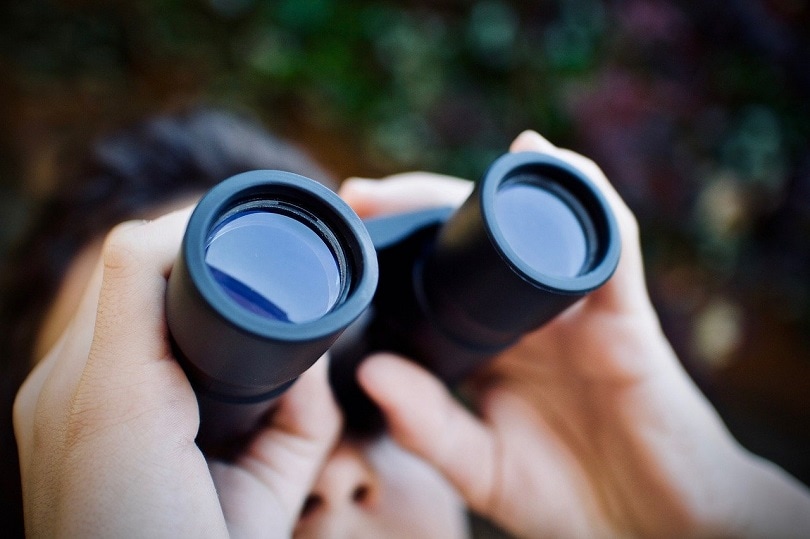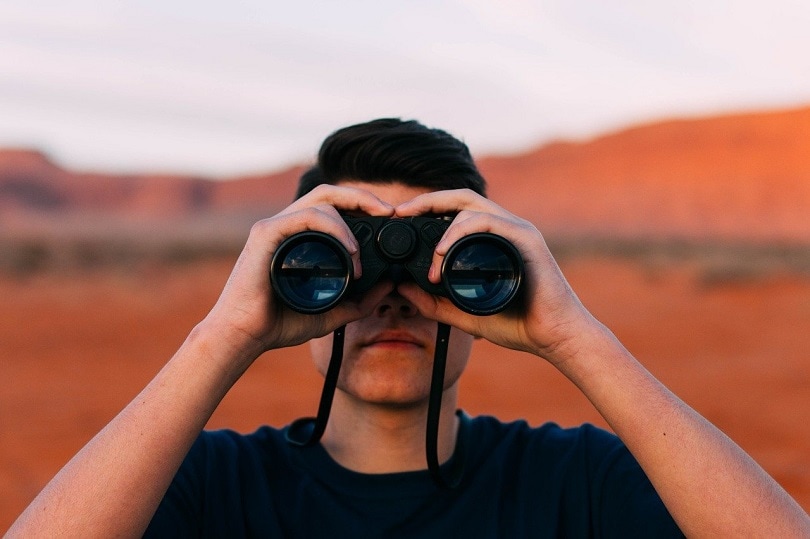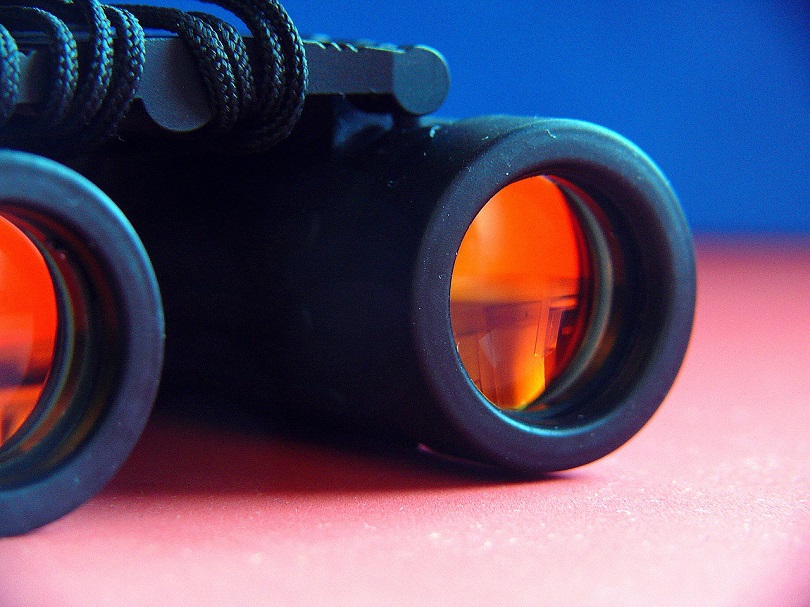What Does 30×60 Mean in Binoculars? Facts & FAQ
Last Updated on

30×60 binoculars are popular, but models with higher and lower numbers exist. The question is, what do those numbers mean? To help you figure that out, let’s take a closer look at 30×60 binoculars.
The numbers on every pair of binoculars follow the same system. The 1st number represents the magnification power (strength) of the binoculars. The 2nd number represents the diameter of the objective lens in millimeters. The objective lens is the large lens on the front end of the binoculars.
In the case of 30×60 binoculars, the magnification power is 30, so an object would appear 30 times closer. The objective lens diameter is 60 millimeters. A pair of binoculars with an objective lens diameter of 40 millimeters or larger is considered full-size. That would make 30×60 binoculars a full-size pair.
As for how far you can see with 30×60 binoculars, that depends on your eyesight. If you have perfect, 20/20 vision, you should see clearly up to 1,000 yards away with 30×60 binoculars. Also, your field of vision would be 378 feet across. That would be wide enough to see landscapes quite well but also smaller objects like animals and plants.
There’s much more to know about binoculars, including how the objective lens size affects their weight, how the magnification affects your field of view, and more. If you’re buying a new pair of binoculars soon and want to know more about them before making a purchase, the in-depth information below will be invaluable.

Are 30×60 Binoculars Considered a Good Size?
When deciding whether a pair of binoculars is a “good size” or not, the first factor to consider is the activity you’re planning to enjoy. For example, if you plan to look at birds in your backyard, a 30×60 pair of binoculars will probably be much bigger and stronger than you need. If you’re trying to spot eagles flying and roosting in Colorado’s Rocky Mountains, however, a 30×60 pair might be too small.
If you plan to do some birdwatching in the woods and fields around your home and also try to spot wildlife, 30×60 binoculars would be fine. They would allow you to see up to 1000 yards away, the length of 10 football fields. You should see the surrounding landscape clearly with 30×60 binoculars and spot birds and other wildlife with no problem. If that’s your plan, 30×60 binoculars would be the best choice.

Why Are They Called a Pair of Binoculars?
While not going into the grammatical details too deeply, the reason they are called a pair of binoculars is rather simple. Telescopes, which feature one eyepiece and one objective lens, were invented a few years before binoculars. One day, a smart human decided that looking through a telescope, while fascinating, was a real pain because you could only use one eye. So, they connected 2 telescopes (a pair of them), and the first “pair” of binoculars was born. Even after binoculars were manufactured as a single device, the term “pair” stuck, like a pair of jeans or a pair of pliers.
How To Choose the Best Binoculars for Your Specific Needs
Below we’ll look at various activities and the ideal size to see and enjoy them best. Keep in mind that there are a wide variety of magnifications and lens size combinations.
Best Hiking Binoculars – 8×22
You need to keep your gear weight down when hiking, and a smaller, 22 mm objective lens would be best. The 8x magnification displays wildlife within a hundred yards, which would be perfect if you were hiking in a wooded area, a canyon, or other relatively enclosed space.
Best Birding Binoculars – 10×42
Birds move fast and cover distances quickly. To see them well and keep them in your field of vision, a 10×42 pair of binoculars would be a good choice. The standard is 8×42, but the extra magnification is worth it if you’re in large fields and open areas. Keep in mind that they will start to get heavy. Bringing a tripod or support is recommended.
Best Whale Watching and Safaris Binoculars – 10×32
When on safari or whale watching, you need a powerful pair of binoculars that isn’t too large and heavy. A 10×32 pair would work well, with plenty of magnification and a large enough field of view to not miss any action. If you were standing still and the weight and size weren’t a problem, you could go with a 10×42 or a 20×42, depending on how far away you were looking.
Best Stargazing Binoculars – 30×42
Stargazing with binoculars can be fascinating but, depending on the size, can also be tiring after a while. That’s why we recommend 30×42 binoculars since the objective lens will let in a lot more light, and their magnification will bring celestial objects much closer. If you invest in a tripod to hold your binoculars for you, you could with a 20×52 or even the 30×60. The more light, the better when looking at stars and planets.
Best On the Water Binoculars – 8×22
If you’re on a kayak or canoe, a smaller pair of binoculars is best since space to store them is limited. A waterproof pair would also be a good idea! Experts recommend an 8×22 pair of binoculars when on the water in small watercraft because the constant motion will make steady viewing a challenge with magnification higher than 8. A 22 mm objective lens is portable and will let in plenty of light.
Best Binoculars for Sporting Events – 7×22
You need small pair of binoculars for sporting events with decent magnification. A pair of 7×22 binoculars will give you the magnification you need, a good field of vision, a small size, and low weight. In short, they’re perfect for baseball games, soccer matches, tennis tournaments, etc.

How Does Objective Lens Size Affect the Field of Vision?
Besides increasing the size and weight, the objective lens controls your field of vision, The larger the diameter, the wider field of vision you will see. For example, with an 8×22 pair of binoculars, the magnification is on the low side, and your field of vision would be limited. An 8×52 would give the same magnification but a much wider field of view. This extra-wide view would be pretty helpful when looking for wildlife in a large area.

What Is the Strongest Magnification Power of Binoculars?
Our research shows that the strongest magnification for binoculars is 160x, which is truly impressive. The company that makes the binoculars is Sunagor. Their Mega Zoom binoculars are 160×170). They weigh just over 3 pounds, so a tripod would be a good idea if you buy them. However, from some of the reviews, the mighty binoculars can be difficult to focus when using higher than 30x magnification.

Conclusion
You now know a 30×60 pair of binoculars means they have 30 magnification and an objective lens size of 60 millimeters. You also know they’re considered a full-sized pair and good for many different viewing activities, including stargazing. If you plan to use them often, a tripod would be a good idea to give your arms and hands a break.
We hope today’s information was helpful and that you understand precisely what those numbers mean on every pair of binoculars. Best of luck choosing your new binoculars, and even better luck spotting something amazing when using them!
Featured Image Credit: Pat_Photographies, Pixabay
About the Author Greg Iacono
Greg Iacono is a self-taught writer and former chiropractor who, ironically, retired early due to back problems. He now spends his time writing scintillating content on a wide variety of subjects. Greg is also a well-known video script writer known for his ability to take a complex subject and make it accessible for the layperson.
Related Articles:
How to Collimate Binoculars: 9 Expert Tips
Binocular Magnification Chart: Numbers & Distances Compared
What Is the Best Binocular Magnification for Hunting? Optical Features Explained
When Were Binoculars Invented? History, Today & Future
Can You Use Binoculars to Look At Stars? How to Choose the Right Pair
How to Choose Binoculars for Bird Watching: 10 Expert Tips
What Does 20X50 Mean on Binoculars? Our Helpful Guide
10 Best Binoculars in Canada of 2024: Reviews & Top Picks
